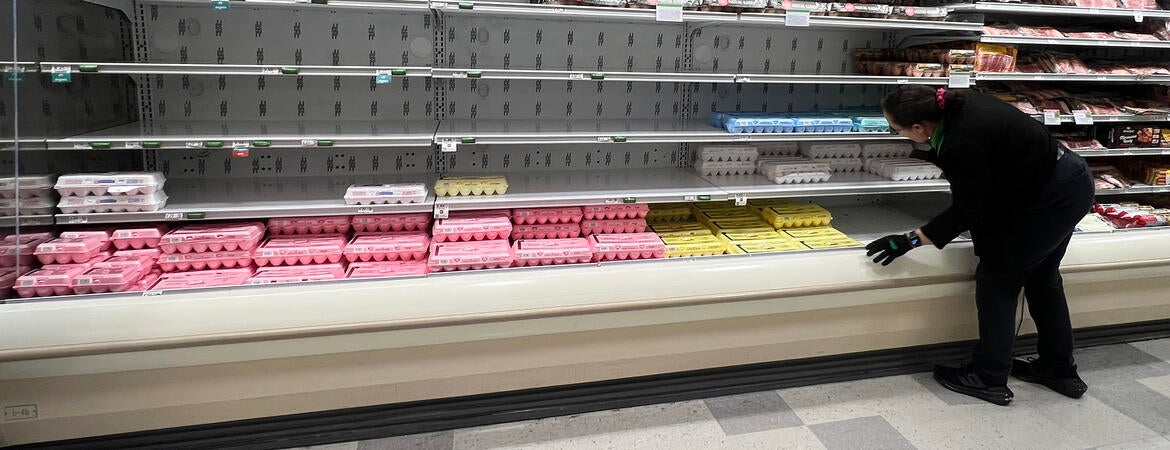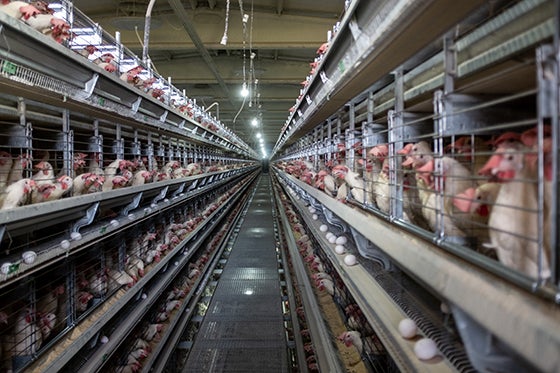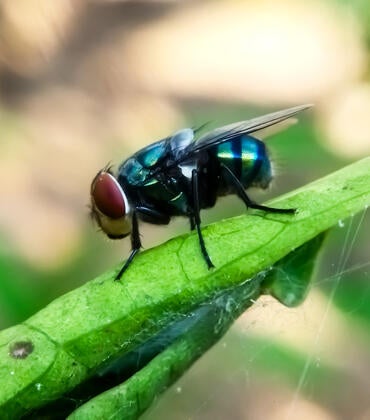
As the spread of bird flu has forced U.S. poultry farmers to cull more than 150 million chickens to contain the contagious avian H5N1 virus, retail egg prices have soared to as high as $9 a dozen and egg supply shortages have left many grocery stores running out between shipments from wholesalers. Here, several UC Riverside experts discuss the high prices and when consumers may get relief. They are Bruce Babcock, an associate dean and professor of public policy and an expert on agriculture economics; Michael Bates, an assistant professor of economics; Amy Murillo, assistant professor of veterinary entomology; and Juliet Morrison, assistant professor of microbiology and plant pathology.
Question: What economic factors, including production risks, have contributed most to the current surge in egg prices following the outbreak?
Bruce Babcock: Egg prices have surged because the supply of eggs has decreased. This decrease was caused by the severe outbreak of avian influenza that has spread through major egg-producing regions of the United States. To slow disease spread, laying hens are killed when an outbreak is found in a production facility. The egg supply is about 7-10% lower than what we would expect supply to be without bird losses. Egg prices are highly sensitive to changes in supply. If supply ever returns to normal, then we would expect egg prices to drop by between 45 and 65%.
Q: How will the chicken/egg industry respond to the shortage? How long before supply is back to normal?
Babcock: We will not return to normal unless bird flu recedes in nature or laying hens develop resistance to the disease.
Q: Given it takes hen hatchlings five to six months to lay eggs, when will the egg market recover from the culling of chicken flocks in response to the bird flu outbreak?
Babcock: Egg producers are continuously trying to replace destroyed hens. If they were not, then egg prices would be even higher than they are. Egg prices will begin to drop when replacement hen production exceeds production losses from culled flocks.
Q: A dozen eggs at a local market is about $9. The average price per dozen was $4.10 at the end of 2024, according to the Bureau of Labor Statistics (BLS). What does this mean for Americans on a fixed income?
Michael Bates: Following a period of rapid inflation, people on fixed incomes find that their income no longer has the same purchasing power, and many may need to cut back on what they buy. In that context, any price increase to a staple such as eggs can be hard felt to people on a fixed income. Since other common sources of protein such as beef, pork, and poultry are generally more expensive, price increases to eggs can be particularly painful, and particularly so for low-earners who may rely more on them.
Q: Is bird flu the only culprit or are there other factors in price increases?
Bates: According to the BLS, egg prices were already rising prior to the detection of bird flu in April 2024, but the recent drastic rise in prices seems primarily driven by the outbreak. A similar but less drastic price spike occurred with the bird flu in January 2023.
Q: How can farmers treat chickens infected with the bird flu virus?
Amy Murillo: There is no treatment for highly pathogenic avian influenza for chickens. Infected chickens show signs of severe illness or death very quickly, and the current standard practice is to euthanize the entire flock if the virus is detected on a property. While there is ongoing research to develop a vaccine, there is nothing currently available for treatment. Instead, prevention through biosecurity is the primary focus. This is so difficult because waterfowl, such as ducks and geese, can spread the disease without becoming seriously ill. The virus can also move on workers’ shoes and clothing.
Q: How extensive is the bird flu problem for U.S. poultry farmers?
Murillo: Since January 2024, over 157,000,000 chickens have been affected by avian influenza. After the initial detection and chicken euthanasia, a farm must remain chicken-free for at least 28 days, though I think it can be much longer depending on the results of environmental sampling. The USDA is reporting that as of November 2024 stocking densities are only down 3% compared to the previous year, but chicken egg/meat demand is overall up, which is likely contributing to high prices and shortages.
Q: Does eating eggs laid by infected chickens present a health risk to people?
Juliet Morrison: While it is unlikely that eggs from virus-infected flocks are making it to supermarket shelves, influenza viruses can transmit from infected hens to the shell and internal contents of their eggs. Cooking eggs until the yolks and whites are solid will kill any viruses present.
Q: How might this outbreak influence future production decisions among poultry farmers, particularly in terms of risk management and investment in preventive measures?
Babcock: Profits are likely near all-time highs for the many egg producers who continue to supply the market. These high profits will keep investment high in the egg industry. One aspect that may warrant increased attention is the overall vulnerability of egg production to disease outbreaks. Over the last 50 years, we have seen tremendous changes in how we produce eggs, broilers, hogs, and milk. Production is now concentrated in large industrial-type facilities. One benefit of moving to industrial production of our food was supposed to be improved security of our food supply because of a better ability to prevent disease outbreaks because of tight phytosanitary protocols adopted by large producers. The severe impacts of avian influenza on egg production and the infection of dairy herds with bird flu reveal that these large operations have not prevented disruptions to our food supply. It will be interesting to see if the movement to more animal-friendly ways of producing food is enhanced or stymied by this disease outbreak.
Q: What types of agricultural policy interventions could help mitigate the negative impacts on both producers and consumers during crises like this?
Babcock: Policies that help prevent future disease outbreaks are the most cost-effective way to secure our food supply. Increased support for U.S. Department of Agriculture’s Animal and Plant Health Inspection Service to monitor and prevent disease outbreak is advisable. Freer trade in agricultural products can also help mitigate any supply disruption because it gives the U.S. access to other countries’ production when our production is disrupted.
Q: Are there historical precedents or economic models that can help us understand the long-term effects of disease outbreaks like bird flu on the poultry and egg markets?
Babcock: About 15 years ago China responded to widespread disease problems in its hog sector by trying to adopt U.S. hog production techniques. Production of baby pigs was kept separate from production of market hogs, and both were produced in large-scale modern factories that were designed to minimize disease outbreaks. This effort failed, however, to prevent huge losses from African swine fever beginning in 2018. Efforts are now underway to combine better phytosanitary conditions with vaccines.
Q: What past examples of agricultural supply shortages related to disease might help us understand the likely recovery of egg supply?
Babcock: Wheat rust is a disease that has reduced wheat supplies in Africa and the Middle East. Over the last 20 years agricultural scientists, government agencies, and molecular biologists have all worked together to try to reduce the impact of rust on wheat supplies. Better monitoring of rust outbreaks, greater effort to breed resistant varieties, and identification of the genes that cause rust are all tools that have been brought to bear to reduce the impact of rust. Such a multi-faceted effort, led by the U.S. government, is what is needed to increase the security of our food supply.
UCR senior public information officers Jules Bernstein and Sandra Baltazar Martínez contributed to this article.








